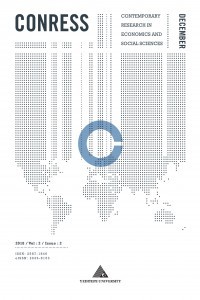Almanya ve Türkiye’de Devlet ve Ulus İnşası Süreçlerinin Kıyaslanması
Almanya ve Türkiye/Osmanlı İmparatorluğu’ndaki devlet gelişim sürecindeki benzerlikler hayret uyandıracak kadar farklılıklardan fazladır. İkisi de geç imparatorluklardı. Merkezi bir siyasi otorite ve homojenleşmiş bir ulus her ikisinde de diğer Batı Avrupa devletlerine kıyasla çok geç gelişti. 17. Yüzyıldan sonra Batı Avrupa devletlerinde merkezi siyasi güç gittikçe kuvvetlenirken iki imparatorlukta da merkezlerin güç kaybetmesi ve dağılması yönünde, yani tam ters yönde bir gelişme ortaya çıktı: her iki imparatorluğu 18. Yüzyıldan itibaren sınırlarda toprak kayıpları ve ufalanmalar karakterize eder. Türkiye ve Almanya’da egemen bir ulusal devletin kurulması ancak orduların liderliğinde ve savaştaki başarılarıyla mümkün oldu çünkü her iki ülkede de burjuvanın liderliği üstlenebilmesi için çok güçsüzdü. Dolayısıyla bütün anahtar mevkiler toplumda ve siyasette hakimiyetini arttıran ordu tarafından tutuldu. Türkiye ve Almanya arasındaki en büyük fark ise demokratikleşme süreçlerindedir: Almanya 1950’lerde oluşmakta olan Avrupa Ortak Pazarı’na entegre edilirken, bilindiği gibi Türkiye Avrupa Birliği üyeliğine halen kabul edilmemiştir.
Anahtar Kelimeler:
merkezileşme, ulus devlet, askeriye/ordu, otokrasi, siyasi güç
Comparison of the State and Nation-Building Processes in Germany and Turkey
The similarities between Germany and Turkey/Ottoman Empire in the state development are astonishingly more than the differences: Both are late empires. While the centralization of political power progressed continuously in the West European states after the 17th Century, an opposite development took place in both empires; in the direction of weakening and disintegration of the centers. Territorial losses and disintegration on the peripheries characterize the both empires. The unification and the creation of a sovereign, national state could be accomplished under the leadership of the armies and by their military success both in Germany and in Turkey. The bourgeoisie of both countries were too weak to play a leading role. Therefore, in both empires all key positions were occupied by the military, which increased its domination and influence in the society and politics. One of the main differences between Turkey and Germany lies in their democratization processes.
Keywords:
centralization, national state, military, autocracy, political power,
___
- Akçam, T. (1993). Türk ulusal kimliği ve Ermeni sorunu. İstanbul: İletişim Yayınları.
- Arai, M. (1992). Turkish nationalism in the Young Turk era. Leiden: E.J. Brill.
- Dabag, M. (1998). Jungtürkische Visionen und der Völkermord an den Armeniern. In M. Dabag & K. Platt (Eds.), Genozid und Moderne: Band 1: Strukturen kollektiver Gewalt im 20. Jahrhundert (pp. 152–205). Wiesbaden: VS Verlag für Sozialwissenschaften. https://doi.org/10.1007/978-3-322-97381-8_7
- Davison, R. H. (1963). Reform in the Ottoman Empire 1856-1876. Princeton: Princeton University Press.
- Elias, N. (1976). Über den Prozess der Zivilisation: Soziogenetische und psychogenetische Untersuchungen (Vol. II). Frankfurt am Main: Suhrkamp Verlag.
- Elias, N. (1978). Was ist Soziologie? München: Juventa Verlag.
- Elias, N. (1983). Engagement und Distanzierung: Arbeiten zur Wissenssoziologie I. Frankfurt am Main: Suhrkamp Verlag.
- Elias, N. (1984). Über die Zeit: Arbeiten zur Wissenssoziologie II. Frankfurt am Main: Suhrkamp Verlag.
- Elias, N. (1987). Die Gesellschaft der Individuen. Frankfurt am Main: Suhrkamp Verlag.
- Elias, N. (1990). Studien über die Deutschen: Machtkämpfe und Habitusentwicklung im 19. und 20. Jahrhundert. Frankfurt am Main: Suhrkamp.
- Elias, N., & Scotson, J. L. (1965). The established and the outsiders; a sociological enquiry into community problems. London: Frank Cass & Co. Ltd.
- Elias, N., Scotson, J. L., & Schröter, M. (1990). Etablierte und Außenseiter. Frankfurt am Main: Suhrkamp.
- Faroqhi, S. (1993). Răuber, rebellen und obrigkeit im osmanischen Anatolien. Periplus 3, 31–46.
- Gawrych, G. W. (1986). The culture and politics of violence in Turkish society, 1903–14. Middle Eastern Studies, 22(3), 307–330.
- Kürşat, E. (2003). Der Verwestlichungsprozeß des Osmanischen Reiches im 18. und 19. Jahrhundert: Zur Komplementarität von Staatenbildungs- und ... Theorien, Prozesse und Migrationen) (1.,). Frankfurt am Main: Iko-Verlag Berlin.
- Kürşat, E. (2004). Zur Verpflichtung der Ehre. In L. Kolago (Ed.), Studien zur Deutschkunde (Vol. XXVII, pp. 77–90). Warschau: UWa.
- Kürşat-Ahlers, E. (1996). Die Brutalisierung der Gesellschaft und Kriegsführung im Osmanischen Reich Während der Balkan Kriege (1903-1914). In A. Gestrich (Ed.), Gewalt im Krieg. Ausübung, Erfahrung und Verweigerung von Gewalt in Kriegen des 20. Jahrhunderts (pp. 51–74). Münster: Lit-Verlag.
- Kürsat-Ahlers, E. (2003). Der Verwestlichungsprozess des Osmanischen Reiches im 18. und 19. Jahrhundert: zur Komplementarität von Staatenbildungs- und Intellektualisierungsprozessen. IKO - Verlag für Interkulturelle Kommunikation, Frankfurt am Main.
- Kushner, D. (1977). The rise of Turkish nationalism, 1876-1908. London: Routledge.
- Mardin, Ş. (1969). Continuity and change in the ideas of the Young Turks. Ankara: Occasional Papers.
- Ramsaur, E. E. (1957). The Young Turks: Prelude to the Revolution of 1908. New York: Princeton University Press.
- Tilly, C. (1990). Coercion, capital, and European states, A.D. 990-1990. Oxford: Basil Blackwell.
- ISSN: 2587-1846
- Başlangıç: 2017
- Yayıncı: Yeditepe Üniversitesi
Sayıdaki Diğer Makaleler
Türkiye’den Göç Etmiş Azınlıklar Diasporasında Kültürel Miras Olarak Türk Dili
Politik Bir Fenomen Olarak Ekmek: 2008 Mısır'ında Ekmek İsyanı
Küresel Finansal Krizin AB Üyelerinde Sermaye Hareketliliğine Olan Etkisi
Osmanlı Tiyatrosu’nda Modernleşmenin İzdüşümleri
Almanya ve Türkiye’de Devlet ve Ulus İnşası Süreçlerinin Kıyaslanması
